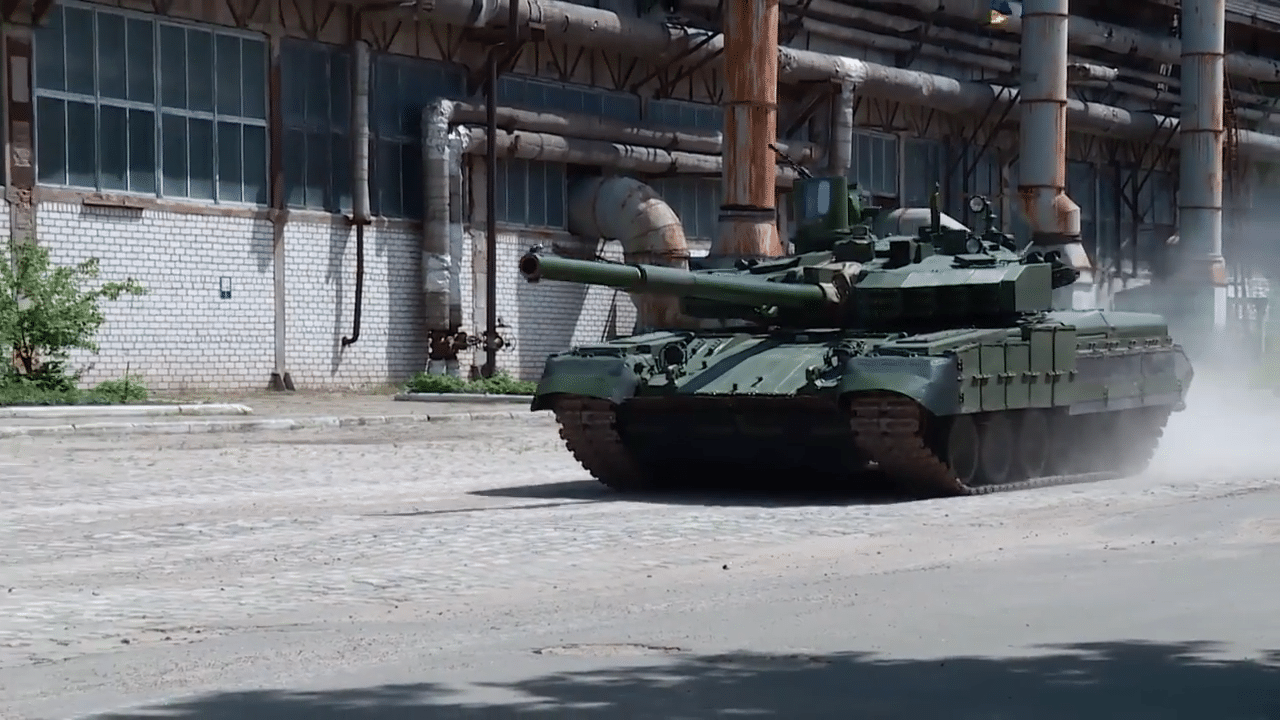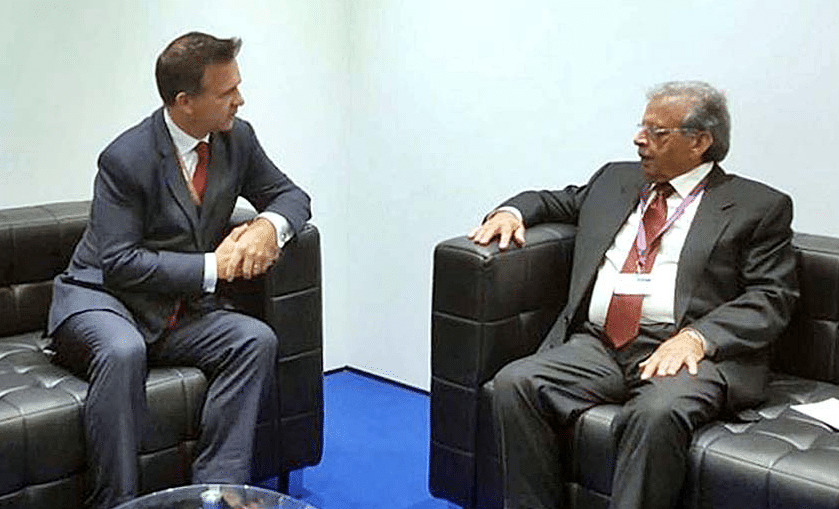2390Views 34Comments

Pakistan will reportedly test a Ukrainian-built ‘Oplot-P’ main battle tank
The Malyshev Factory in Kharkiv, Ukraine rolled out an Oplot main battle tank (MBT) and conducted a mobility test of it on Friday, June 23 with Ukraine’s Interior Minister Arsen Avakov and Secretary of the National Security Defence Council Oleksandr Turchynov in attendance.
Ukrainian news outlets, such as Depo Harkiv, claim – citing Malyshev Factory employees – that this specific Oplot MBT – dubbed “Oplot-P – will be sent to Pakistan.
This comes following recent reports from Ukrainian media of the Oplot MBT drawing Pakistani interest.
In April, Delovaya Stolitsa interviewed Pakistan’s Ambassador to Ukraine Maj. Gen (retired) Athar Abbas, who told Delovaya Stolitsa that Pakistan could be interested in 100 Oplot MBT.
At the end of the May, Podrobnosti reported of the Malyshev Factory completing an Oplot MBT destined for Pakistan, but for testing as part of a tender. Pakistan had tested the Oplot-M in 2015 as well.
Notes & Comments:
The Pakistan Army has 320 T-80UD MBTs, which it ordered from Ukraine in 1996. The al-Khalid and al-Zarrar MBTs are powered by Ukrainian diesel engines as well.
The surge of Pakistani interest in Ukrainian armour solutions stems from recent agreements signed by Kiev and Islamabad in late 2016 and early 2017.
At Pakistan’s biennial defence exhibition IDEAS in Karachi in November, Heavy Industries Taxila (HIT) signed a $600 million U.S. memorandum-of-understanding (MoU) with Ukrspecexport for 200 diesel engines for the al-Khalid MBT alongside maintenance and modernization support.
This was followed by another MoU in February 2017 during IDEX 2017 in Abu Dhabi, this time between the Pakistan Ministry of Defence Production (MoDP) and Ukroboronprom. The MoDP stated that the MoU outlined cooperation “in building, modifying, rebuilding and upgrading tanks in Pakistan.” The MoDP was quoted (by Geo News) stating that the MoU also involved the co-production of tank engines.
Pakistan began activating these MoUs in March with a contract for 88 tank sights for the Army’s T-80UDs.
The Podrobnosti report states that the new-build Oplot is meant for testing (i.e. not as part of an actual order), meaning, Pakistan has yet to decide on pursuing the Oplot. It is not known if this new-built model incorporates updates or Pakistani-specific changes. For example, Pakistan may be interested in the new 6TD-3 1,500 hp diesel engine, especially for the forthcoming HIT al-Khalid 2 MBT.
In 2015, Pakistan had tested several MBTs, specifically the Oplot-M and Chinese NORINCO VT4, as part of the “Haider” MBT program. The Haider was envisaged as a complementary MBT to the al-Khalid series, which was intended to form the future mainstay of the Pakistan Army’s tank forces. It is not known if the Haider program is still alive or if there is any relation to today’s apparent interest in the Oplot.
The Oplot-M is the latest variant of the T-84, which is an upgrade of the T-80UD MBT. Although it is based on the same chassis as the T-84/T-80D, the Oplot-M boasts a new welded turret armed with a 125mm KBA3 smoothbore gun and carousel automatic shell loader, which can fire numerous types of tank shells and anti-tank guided missiles. Its defensive systems include the Nozh explosive reactive armour, Varta soft-kill active protection suite (APS) and, in time, Zaslon hard-kill APS.
Originally a higher cost system meant for export, the Ukrainian Army will also begin inducting Oplot MBTs.
Additional information on the Oplot-M can be found on Quwa.



34 Comments
by Shakeel
Do you feel that the Geo assertion that Pakistan will be co-producing engine parts is credible & taken seriously by Pak defence planners? Can you once again shed some light on this issue.?
Does the above tank for testing have an improved engine?
Many thanks?
by Bilal Khan
Geo basically quoted the MoDP point-blank, so it wasn’t their assertion in as much as their claim of hearing the MoDP say it. In that respect, I take it more seriously than I would Geo just saying that Pakistan would co-produce engines or engine parts.
As for the Oplot-P. We’ll need to wait and see. I remember hearing that the Pakistan Army rejected the Oplot the first time due to engine problems, which makes zero sense as the Oplot’s standard powerplant is the 1,200 hp 6TD-2 – i.e. the al-Khalid’s engine! Now if it was using a new engine, e.g. the 6TD-3, then that explanation would make much more sense.
by Muhammad Irfan
Why Not ALTAY tank instead of Oplot with joint production and TOT?
by SS_IND
How does the Oplat-P compare to the M1A2 Abrams, T-90 SM, T-14 Armata and Leopard ??
by Bilal Khan
The PA might consider the Altay’s electronics and armour technology, but the complete Altay MBT system is very expensive.
by Haris
What I can’t really understand is that of India is beefing up her air Force at such an alarming rate and our air Force is facing cash crunch and there is no SAM system in sight then how our land assets will stand up to a close air assault of IAF particularly with their air to ground munition. They will blow out our mlrs, tanks and apcs just with a concentration air attack. Has this been considered?
by Haris
Why is Pakistan ever investing high in armour only. Why not twin engine air assets are on table. The gap between Paf and Iaf is ever widdening and without proper air support I don’t think our land assets count on Punjab plains. They will sitting dicks to Indian rafales and SU 30 and may be F 16V.
by Steve
We do need both as there are 1000 tanks sitting on our border. However, I agree the priority should be air defence, HQ-9/HQ-16 and more CAS fighters carrying stand off weapons and things like sensor fused weapons for armour and thermobaric weapons for truck based infantry, along with more helicopters to protect our land forces. The aim is to stop Cold Start without using TNW. Yet more armour at the cost of other services risks the army becoming increasingly one dimensional. The Middle East wars showed how armour can be largely destroyed from the air even before engaged by friendly land forces. I hope it’s not political between services. If we need more tanks we should make sure that we manufacture them to reduce costs. Opolot-P, Altay or any tank we buy needs to be carefully evaluated, as knowing our adversary, we will almost certainly be facing Armata in the near future. On a different note, did you guys see the 56’er hugger-in-chief hugging Trump, who looked distinctly uncomfortable. The guy never fails to perform his signature move ?. Remains to be seen how effective it was.
by kaster
Bilal didn’t the PA reject Altay because it was to much heavy and unsuitable for Pakistan landscape.
by Aamir
What is the difference between the Oplot – M & the Oplot-P?
by Hassan Raza
Hi Bilal,
I heard that Pakistan will not only purchase oplot tanks but will also upgrade their present 320 T-80UD tanks to T-84 and further to oplot-m if possible. Is there any possibility of it?
by Talha Ahmed Moin
Su-30 isnt a problem, Rafale is
by Eqbal Khan
Military should not be run by MBA’s. Essential Technology should be one important goal. Pakistan missed most of the opportunities and offers because of cost and that we do not need a large number of items. Examples range from Mirage to Ukrainian transport aircraft. Pakistan will miss most of the opportunities again. Its the mindset of the people in-charge of procurement. They rarely act in national interest. If they did, we would have a lot more technology than we have and we would not be struggling.
by Atif Javed
Abram tank is alot experience and equally effective as oplot m or p but yes leopard tank is a beast t90s are old tanks have no comparison with latest oplot tank
by Atif Javed
Oplot tank is impressive we are intrested in this tank because of a reason we are already using 320 t80 ud and 82 more are on order also 200 new engines are on order for 600 millions dollars so… we are planning to get oplot m for licensed build than we can also upgrade our 400 t80s to same standard its great for pakistan to get new and old tank at same standard
by Atif Javed
Yes haris air force is reall game in war but dont forget the importance of ground force you can attack with air force but you can’t get control on enemy teritory with for arm forces for modernization thread yes we need to concentrate on this thread actually we are not that much stronge economic country we need to arrange 15 billion dollars for a decades installments program to upgrade f16s and also upgrade new blocks of jf17 and try to get f35 or j20 only not to smile its possible need some real governance
by Steve
I seem to recall there was a MoU on engine production with Ukraine at IDEAS 2016.
by umar rana
so what is the value of al-khalid tank program?Is it a junk?
how many we sold?
If we buying so many engines then they should be build in pakistan transfer of technology?
are we wasting money on al-khalid. whre it stand in the world tank battles sale point of view?????
by Bilal Khan
We’ll need to wait and see how the Oplot fits.
Seeking an imported tank need not be an indictment on the al-Khalid. Pakistan’s R&D capabilities are limited, so in many cases it has to acquire new technology (e.g. for armour, defensive aids, etc) from abroad with ToT. The likes of Ukraine won’t part from that technology without Pakistan purchasing hardware.
The other angle is accelerating the procurement road map. HIT’s optimal roll-out rate for the al-Khalid is in the range of several dozen tanks per year. While expanding the production line is an option, once the acquisition period is complete, you end up with expanded infrastructure (i.e. a cost) that might not be used at that rate again. It might just be cheaper to import tanks in parallel to maxing out your current al-Khalid rate.
Technically speaking, the al-Khalid is a contemporary tank and the al-Khalid 2 will be a solid upgrade.
by Bilal Khan
We’ll need to wait and see.
by Bilal Khan
Not aware of them actually testing the Altay in the first place.
by Bilal Khan
Probably very little or nothing. Could just be a nominal product code (e.g. Oplot-T for Thailand).
by Bilal Khan
The PAF’s focus is to flesh out its mainstay fleet with the JF-17. Yes there is no doubting the JF-17’s deficiencies, but with a good technology package (via Block-III) it could emerge as a viable defensive air asset, especially in numbers. It’d be wiser to bring top-notch subsystems and weapons from other platforms to the JF-17.
by Mazhar J
While living in North America for a long time, I can tell that (Socially) people over here don’t like to hug the way Modi does, specially men. But this fool can’t resist to hug.
by Syed Arbab Shah
If we are satisfied with the Oplot P, specially it’s engine then it’s a done deal. Adding Turkish Electronics and Armour into it, will make it a great tank.
What more could be added or rather what improvement are we expecting that would make AL Khalid 2 tank Formidable?
Yes we are going to go step by step and yes we are going to test before inducting any equipment. Yes we don’t have deep pockets.
Is it going to be Chinese specially in regard to Type 99 tank or is it something from the west which was not assessable before or through Turkey, which is going to become our AL Haidar tank?
If it’s Chinese or from some other source, then why are we not adding the qualities of the AL Haidar tank into the Oplot P, when it is only in the initial stages of development/procurement?
I hope you got my point.
by Bilal Khan
Part of me wonders … is Pakistan really interested in the Oplot … or Ukraine’s long-term tank development? The Futuristic Main Battle Tank (FMBT) concept was officially revealed by Ukroboronprom in 2014 and most of the subsystems promoted then have since been developed or are nearing completion. The only thing that we’ve yet to see (from the FMBT) is the new turret.
https://www.youtube.com/watch?v=6gHOToPckCI
by Steve
FMBT would do be good as it is ‘future proof’ in the medium term at least. Even if our adversaries buy Armata. Excellent video Bilal, thanks. It looks expensive but we definitely need a closer look.
by Van der Decken
Oplot-T includes AC (Air Conditioning) and APU (Auxiliary Power Unit) as was asked by the Thailand officials.
by Van der Decken
From a technical perspective, this is possible.
However, a complete set of new parts will include:
Active Protection System “Varta”
6TD-2E engine
New gearbox
“Reactive armour “Duplet”
New Fire-control system
and a lot more of minor changes.
by Syed Arbab Shah
http://micetimes.asia/for-the-sake-of-a-rupture-with-russia-ukraine-will-rework-guns/
by jigsaw
Hello guys 🙂
by Abdul Rashid
Oh hello Jigsaw! Great to see you back on Quwa again after a long absence. This thread is now closed for further comments. I briefly re-opened it to welcome you back. Looking forward to your input.
by jigsaw
Thanks bro. Looks like the thread is still opened 😀
by Abdul Rashid
Thanks for letting me know. I will close it now.